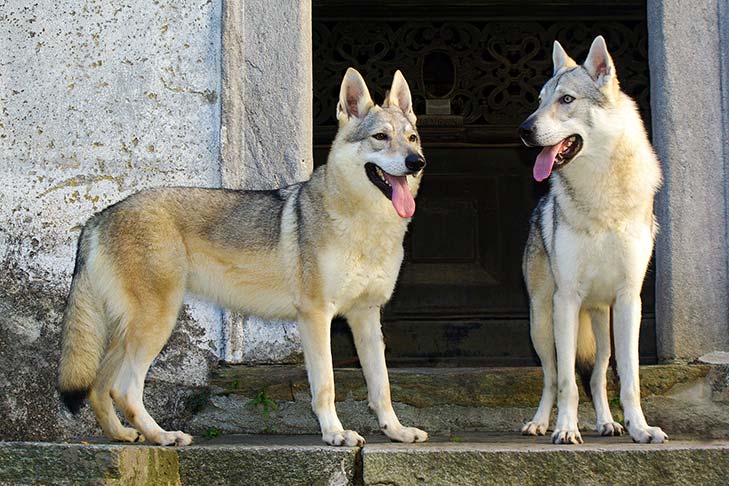
The Czechoslovakian Vlcak (also called the Czechoslovakian Wolfdog) is a relatively modern breed with a striking wolf-like appearance and an impressive working heritage. It was developed in 1955 as a military experiment in former Czechoslovakia, combining German Shepherds with Carpathian wolves to create a durable, trainable, and highly intelligent working dog with the stamina and instincts of a wolf.
Originally intended for border patrol and military duties, the Vlcak proved to be strong, agile, and highly adaptable. Over time, the breed was refined to retain wolfish looks with a reliable, cooperative temperament. It was officially recognized by the Fédération Cynologique Internationale (FCI) in 1989, and it has since gained a devoted following among experienced dog handlers, trainers, and canine sport enthusiasts.
The Vlcak remains rare but highly respected, especially in Europe, where it's used in search and rescue, tracking, protection work, and advanced obedience. It is growing in popularity in the United States and other countries thanks to its unique appearance, working potential, and intense loyalty.
This is a breed that appeals most to experienced, active dog owners who appreciate its intelligence, strength, and challenge.
The Vlcak looks almost indistinguishable from a wolf, yet it moves with the discipline and control of a trained dog.
• Coat: Straight, dense double coat that’s short to medium in length, well-suited to cold climates.
• Color:
o Wolf-gray, with a light mask on the muzzle and chest.
o Some dogs may appear silver-gray or yellow-gray.
• Size:
o Height: 24–26 inches (60–65 cm)
o Weight: 44–57 lbs (20–26 kg)
• Head & Expression: Broad skull with amber, almond-shaped eyes and a powerful jaw.
• Ears: Erect, triangular, and small in proportion to the head.
• Tail: Bushy and carried low when relaxed, curled slightly when excited.
• Body: Lean, muscular, and athletic with a deep chest and long limbs. The breed’s gait resembles a trotting wolf—light, fluid, and enduring.
The Vlcak is known for its loyalty, energy, and complex personality, combining the intelligence of the German Shepherd with the instinctual behaviors of the wolf.
• Highly Intelligent and Observant: Quick to learn, but needs engaging, challenging tasks.
• Loyal to the Core: Extremely bonded with its family—may be aloof or distrustful of strangers.
• Independent and Curious: Exhibits strong self-direction, especially if not trained early.
• Protective but Not Aggressive: Naturally territorial, but not overly confrontational.
• Energetic and Driven: Needs ample daily exercise and mental stimulation.

This breed is an excellent match for those who want a devoted, athletic, and highly trainable working companion—and who have the time and experience to manage its needs.
• Ideal for Active Lifestyles: Perfect for hiking, running, tracking, and dog sports.
• Loyal Guardian: Wary of strangers, making it a good natural protector.
• Visually Striking: Its wolf-like looks and athletic movement are sure to turn heads.
• Versatile Worker: Excels in obedience, agility, search and rescue, and protection training.
• Bond-Driven: Forms a deep, often lifelong attachment to its handler.
This breed requires committed, consistent, and experienced handling, along with daily physical and mental outlets.
• Training:
o Needs early socialization and firm but positive leadership.
o Not a breed for casual or novice dog owners.
o Thrives in structured environments with clear rules.
• Exercise:
o Requires 2+ hours of activity daily. Loves long-distance running, scent work, and obedience drills.
o Gets bored quickly without stimulation—may become destructive.
• Grooming:
o Low maintenance—brush weekly, more during seasonal shedding.
o Bathing should be infrequent to maintain coat oils.
• Nutrition:
o Feed a high-protein, working-dog formula. Some may do well on a raw or hybrid diet.
• Companionship:
o Must live closely with its people—does not thrive in isolation.
o Can be challenging in multi-pet households if not socialized early.

The breed is generally robust and long-lived, often reaching 12–16 years with proper care. However, potential issues include:
• Hip Dysplasia
• Degenerative Myelopathy
• Eye Disorders
• Bloat (Gastric Dilatation-Volvulus)
• Behavioral issues without adequate stimulation or leadership
Routine vet care and ongoing physical and mental work are essential for a well-balanced Vlcak.
Compared to the German Shepherd, the Vlcak is less biddable but more resilient and independent. Unlike the Siberian Husky, which is playful and sociable, the Vlcak is serious, reserved, and more bonded to one or two people. It also shares traits with the Belgian Malinois, though it tends to be more instinctual and sensitive.
Among wolfdog-type breeds, it is considered the most stable and trainable, thanks to its shepherd ancestry.
The Vlcak is best for highly experienced dog owners who are active, confident, and dedicated to training. If you want a loyal, intelligent, and unique canine partner, and you're ready to commit to its needs, this breed will offer unwavering loyalty and incredible ability.
However, if you’re a first-time dog owner, live in a small space, or want a relaxed companion, the Vlcak is not a good match.
United Pet Club is here to help you connect with this incredible working breed. Whether you're seeking reputable breeders, training support, or health and care resources, we’re here to assist you.
Explore our platform to learn more about the Czechoslovakian Vlcak, and begin your journey with one of the most majestic and loyal canine companions in the world.